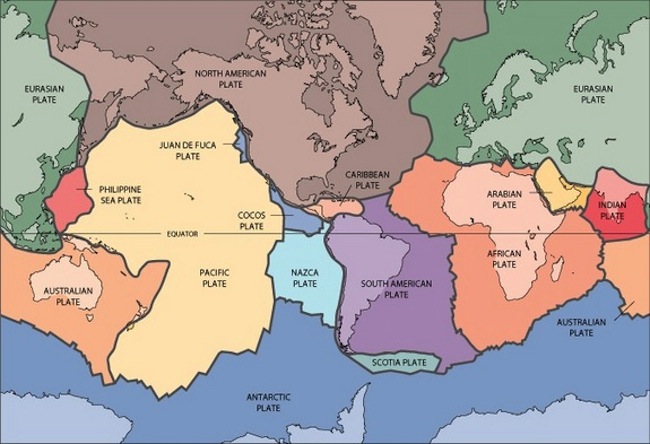What Is One Piece of Evidence That Wegener Used to Support His Continental Drift Hypothesis?
Continental Drift: The groundbreaking theory of moving continents

Continental drift was a revolutionary theory explaining that continents shift position on Globe'south surface. The theory was proposed past geophysicist and meteorologist Alfred Wegener in 1912, but was rejected by mainstream science at the time. Scientists confirmed some of Wegener's ideas decades later, which are at present part of the widely accepted theory of plate tectonics.
Wegener's continental drift theory introduced the idea of moving continents to geoscience. He proposed that Earth must have in one case been a single supercontinent before breaking up to form several unlike continents. This explained how like rock formations and plant and brute fossils could be on separated continents. Modern science recognizes this ancient supercontinent called Pangaea did exist before breaking up about 200 one thousand thousand years agone, equally Wegener theorized.
Related: Massive supercontinent volition course hundreds of millions of years from now
Why did scientists reject Wegener's continental drift theory?
Geologists roundly denounced Wegener'southward continental migrate theory afterwards he published the details in a 1915 volume chosen "The Origin of Continents and Oceans." Part of the opposition was because Wegener didn't have a skillful model to explain how the continents moved, something scientists afterwards explained under the umbrella of plate tectonics — the theory that Earth's chaff is fractured into plates that move over a rocky inner layer called the mantle.
"There'due south an irony that the key objection to continent drift was that at that place is no machinery, and plate tectonics was accepted without a mechanism," to move the continents, Henry Frankel (1944–2019), an emeritus professor at the University of Missouri-Kansas City and writer of the four volume "The Continental Drift Controversy" (Cambridge University Press, 2012) previously told Live Science.
Though most of Wegener'south observations about fossils and rocks were correct, he was outlandishly wrong on a couple of key points. For instance, Wegener idea the continents might accept plowed through the ocean chaff like icebreakers nifty through ice.
Evolving theories
When Wegener proposed continental drift, many geologists were contractionists. They idea Earth's incredible mountains were created because our planet had been cooling and shrinking since its formation, Frankel said. And to account for the identical fossils discovered on continents such every bit South America and Africa, scientists invoked ancient land bridges, now vanished below the sea.
Researchers argued over the country bridges right up until the plate tectonics theory was adult from the 1950s to the 1970s, Frankel said. For example, every bit geophysicists began to realize that continental rocks were besides lite to sink downward to the ocean floor, prominent paleontologists instead wrongly suggested that the similarities betwixt fossils had been overestimated, Frankel said.
Plate tectonics is like a modernistic update to continental migrate. In the 1960s, scientists discovered plate edges through magnetic surveys of the ocean floor and through the seismic listening networks built to monitor nuclear testing, co-ordinate to Encyclopedia Britannica. Alternating patterns of magnetic anomalies on the ocean flooring indicated seafloor spreading, where new plate material is born. Magnetic minerals aligned in ancient rocks on continents also showed that the continents have shifted relative to ane another.
Related: Plate tectonics are 3.half-dozen billion years erstwhile, oldest minerals on Earth reveal
What evidence is there for continental drift?

A map of the continents inspired Wegener's quest to explain Earth'southward geologic history. He was intrigued by the interlocking fit of Africa's and South America's shorelines. Wegener then assembled an impressive amount of continental drift prove to show that Earth'southward continents were once connected in a single supercontinent.
Wegener knew that fossil plants and animals such every bit mesosaurs, a freshwater reptile found only in South America and Africa during the Permian menstruation, could be found on many continents. He as well matched upwards rock formations on either side of the Atlantic Ocean like puzzle pieces. For case, the Appalachian Mountains (United states) and Caledonian Mountains (Scotland) fit together, every bit do the Karoo strata in South Africa and Santa Catarina rocks in Brazil.
In fact, plates moving together created the highest mountains in the earth, the Himalayans, and the mountains are still growing due to the plates pushing together, fifty-fifty at present, according to National Geographic. Despite his incredible continental drift evidence, Wegener never lived to see his theory gain wider acceptance. He died in 1930 at historic period 50 just two days afterward his birthday while on a scientific expedition in Greenland, according to the Academy of Berkeley.
Additional resources
- Acquire more about the history of continental drift and plate tectonics from the U.S. Geological Survey.
- Learn more near Alfred Wegener from the NASA Earth Observatory.
- Watch this curt video on YouTube virtually plate tectonics and continental drift, from National Geographic.
This article was updated on December. 14, 2021, by Live Scientific discipline Staff Author Patrick Pester. Additional reporting by Alina Bradford, Live Science contributor.
Source: https://www.livescience.com/37529-continental-drift.html
0 Response to "What Is One Piece of Evidence That Wegener Used to Support His Continental Drift Hypothesis?"
Post a Comment